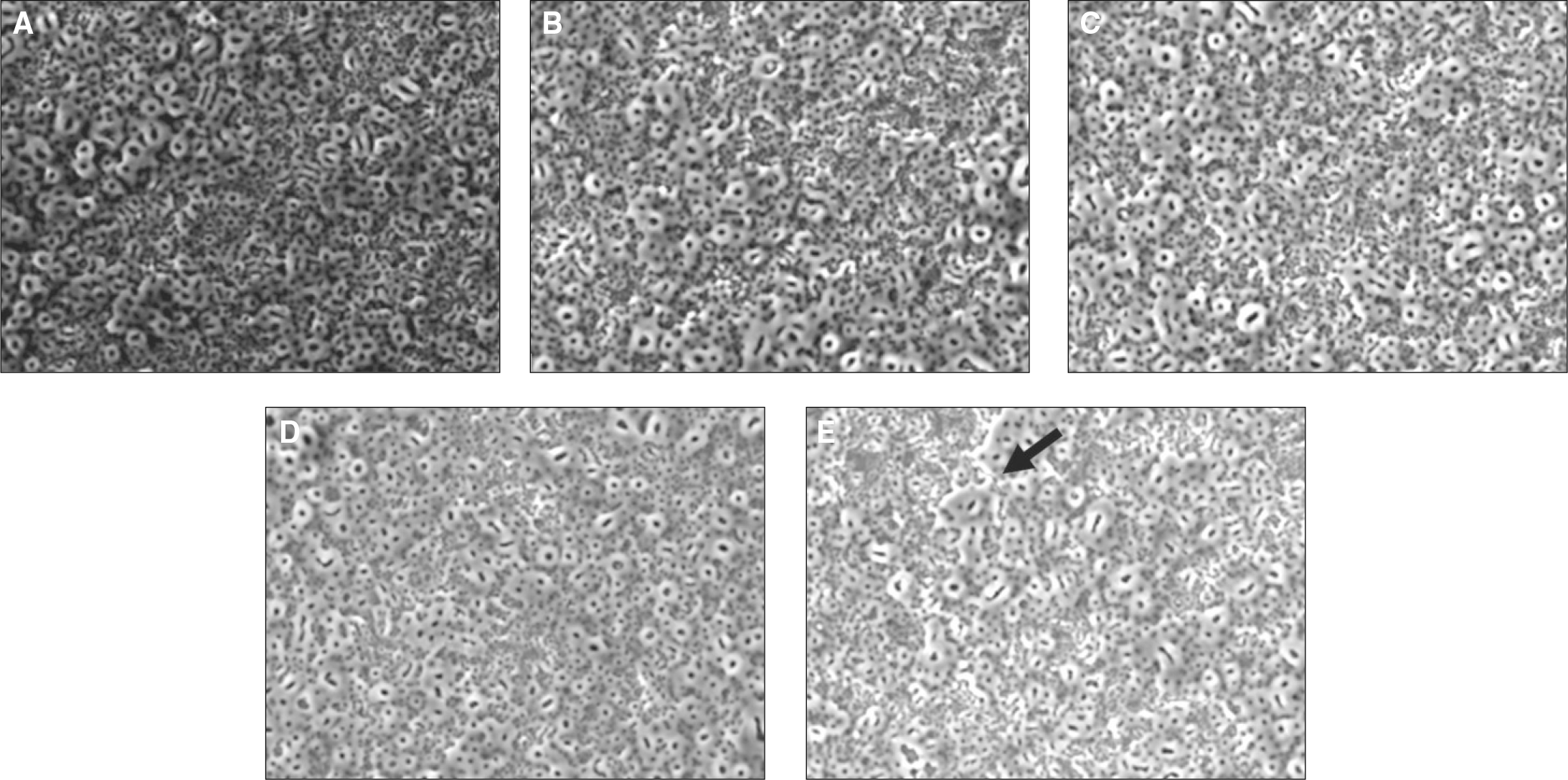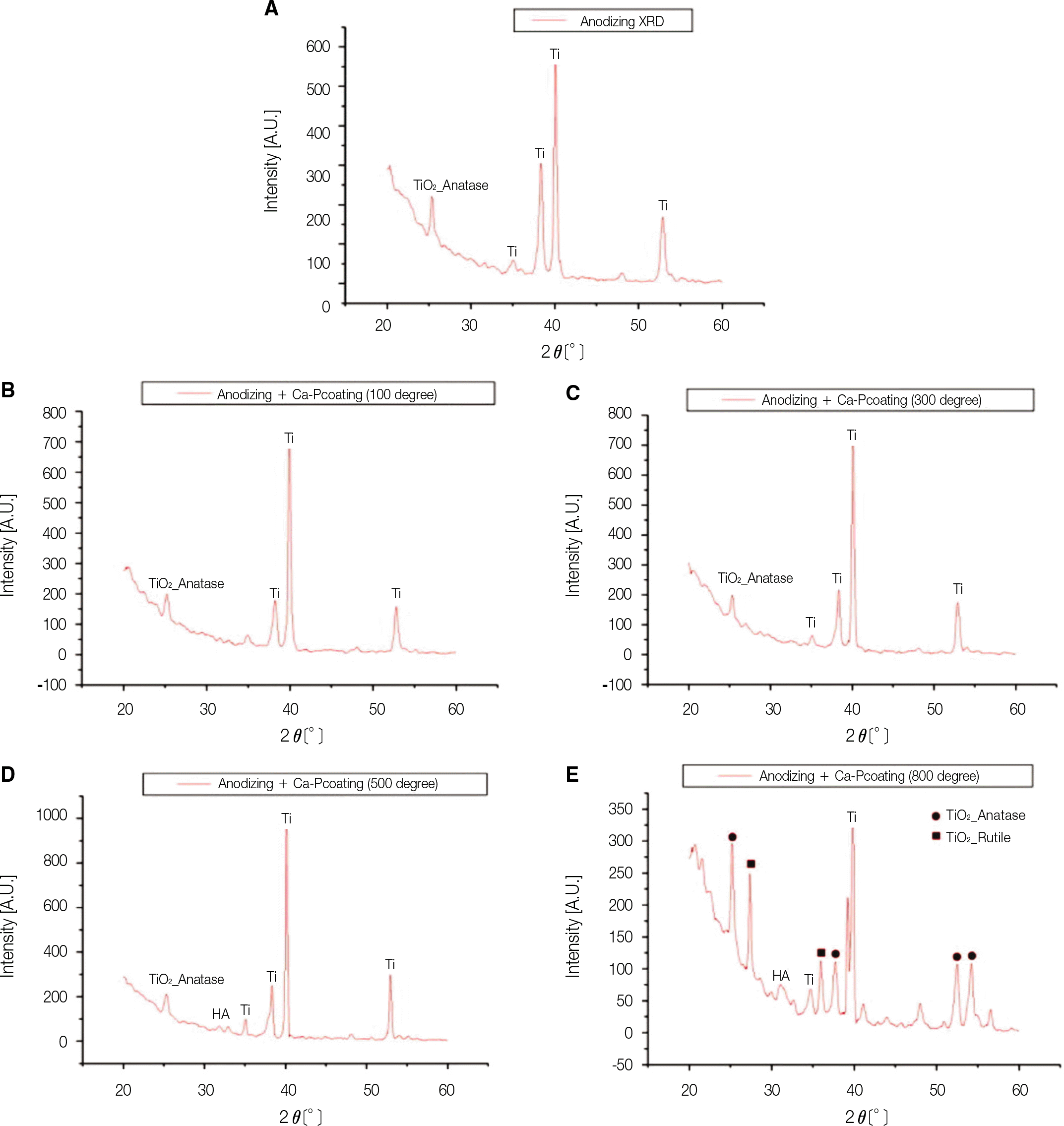This article has been corrected. See "Erratum: The effect of different crystallization temperature of the hydroxyapatite coating produced by ion beam-assisted deposition on anodizing-treated titanium disks on human osteosarcoma cells" in Volume 50 on page 216.
Abstract
Purpose
The aim of this study was to study the effect of hydroxyapatite (HA) coating crystallinity on the proliferation and differentiation of human osteosarcoma cells.
Materials and methods
Surface roughness of the titanium disks increased by anodizing treatment and then HA was coated using ion beam-assisted deposition (IBAD). HA coating was crystallized by heat-treated at different temperature (100℃, 300℃, 500℃, 800℃). According to the temperature, disks were divided into four groups (HA100, HA300, HA500, HA800). With the temperature, crystallinity of the HA coating was different. Anodized disks were used as control group. The physical properties of the disk surface were evaluated by surface roughness tests, XRD tests and SEM. The effect of the crystallinity of HA coating on HOS cells was studied in proliferation and differentiation. HOS cells were cultured on the disks and evaluated after 1, 3, 5, and 7 days. Growth and differentiation kinetics were subsequently investigated by evaluating cell proliferation and alkaline phosphatase activity.
Go to : 
REFERENCES
1.Albrektsson T., Wennerberg A. Oral implant surfaces: Part 1-review focusing on topographic and chemical properties of different surfaces and in vivo responses to them. Int J Prosthodont. 2004. 17:536–43.
2.Ishizawa H., Ogino M. Formation and characterization of anodic titanium oxide films containing Ca and P. J Biomed Mater Res. 1995. 29:65–72.

3.Yerokhin AL., Nie X., Leyland A., Matthews A., Dowey SJ. Plasma electrolysis for surface engineering. Surf Coat Technol. 1999. 122:73–93.

4.Li LH., Kim HW., Lee SH., Kong YM., Kim HE. Biocompatibility of titanium implants modified by microarc oxidation and hydroxyapatite coating. J Biomed Mater Res A. 2005. 73:48–54.

5.Brossa F., Cigada A., Chiesa R., Paracchini L., Consonni C. Post-deposition treatment effects on hydroxyapatite vacuum plasma spray coatings. J Mater Sci Mater Med. 1994. 5:855–7.

6.Rohrer MD., Sobczak RR., Prasad HS., Morris HF. Postmortem histologic evaluation of mandibular titanium and maxillary hydroxyapatite-coated implants from 1 patient. Int J Oral Maxillofac Implants. 1999. 14:579–86.
7.Hanisch O., Cortella CA., Boskovic MM., James RA., Slots J., Wikesjo ¨ UM. Experimental peri-implant tissue breakdown around hydroxyapatite-coated implants. J Periodontol. 1997. 68:59–66.

8.Liao H., Fartash B., Li J. Stability of hydroxyapatite-coatings on titanium oral implants (IMZ). 2 retrieved cases. Clin Oral Implants Res. 1997. 8:68–72.
9.Watson CJ., Tinsley D., Ogden AR., Russell JL., Mulay S., Davison EM. A 3 to 4 year study of single tooth hydroxylapatite coated endosseous dental implants. Br Dent J. 1999. 187:90–4.

10.Jung YC., Han CH., Lee IS., Kim HE. Effects of ion beam-assisted deposition of hydroxyapatite on the osseointegration of endosseous implants in rabbit tibiae. Int J Oral Maxillofac Implants. 2001. 16:809–18.
11.Le IS., Kim DH., Kim HE., Jung YC., Han CH. Biological performance of calcium phosphate films formed on commercially pure Ti by electron-beam evaporation. Biomaterials. 2002. 23:609–15.

12.Overgaard S., Bromose U., Lind M., Bu ¨nger C., S � balle K. The influence of crystallinity of the hydroxyapatite coating on the fixation of implants. Mechanical and histomorphometric results. J Bone Joint Surg Br. 1999. 81:725–31.
13.Oh S., Tobin E., Yang Y., Carnes DL Jr., Ong JL. In vivo evaluation of hydroxyapatite coatings of different crystallinities. Int J Oral Maxillofac Implants. 2005. 20:726–31.
14.Sul YT. The significance of the surface properties of oxidized titanium to the bone response: special emphasis on potential biochemical bonding of oxidized titanium implant. Biomaterials. 2003. 24:3893–907.

15.Li LH., Kong YM., Kim HW., Kim YW., Kim HE., Heo SJ., Koak JY. Improved biological performance of Ti implants due to surface modification by microarc oxidation. Biomaterials. 2004. 25:2867–75.

16.Ishizawa H., Ogino M. Characterization of thin hydroxyapatite layers formed on anodic titanium oxide films containing Ca and P by hydrothermal treatment. J Biomed Mater Res. 1995. 29:1071–9.

17.Sul YT., Johansson CB., Jeong Y., Albrektsson T. The electrochemical oxide growth behaviour on titanium in acid and alkaline electrolytes. Med Eng Phys. 2001. 23:329–46.

18.Sul YT., Johansson CB., Petronis S., Krozer A., Jeong Y., Wennerberg A., Albrektsson T. Characteristics of the surface oxides on turned and electrochemically oxidized pure titanium implants up to dielectric breakdown: the oxide thickness, micropore configurations, surface roughness, crystal structure and chemical composition. Biomaterials. 2002. 23:491–501.
19.Hirai T., Ishijima T., Hashikawa Y., Yajima T. Osteoporosis and reduction of residual ridge in edentulous patients. J Prosthet Dent. 1993. 69:49–56.

21.Dunn B., Reisbick MH. Adherence of ceramic coatings on chromium-cobalt structures. J Dent Res. 1976. 55:328–32.

22.Yang Y., Kim KH., Ong JL. A review on calcium phosphate coatings produced using a sputtering process-an alternative to plasma spraying. Biomaterials. 2005. 26:327–37.

23.Cook SD., Thomas KA., Kay JF., Jarcho M. Hydroxyapatite-coated titanium for orthopedic implant applications. Clin Orthop Relat Res. 1988. 232:225–43.

24.Cui FZ., Luo ZS., Feng QL. Highly adhesive hydroxyapatite coatings on titanium alloy formed by ion beam assisted deposition. J Mater Sci Mater Med. 1997. 8:403–5.
25.Wang S., Lacefield WR., Lemons JE. Interfacial shear strength and histology of plasma sprayed and sintered hydroxyapatite implants in vivo. Biomaterials. 1996. 17:1945–70.

26.Choi JM., Kong YM., Kim S., Kim HE., Hwang CS., Lee IS. Formation and characterization of hydroxyapatite coating layer on Ti-based metal implant by electron-beam deposition. J Mater Res. 1999. 14:2980–5.

27.Martin JY., Schwartz Z., Hummert TW., Schraub DM., Simpson J., Lankford J Jr., Dean DD., Cochran DL., Boyan BD. Effect of titanium surface roughness on proliferation, differentiation, and protein synthesis of human osteoblast-like cells (MG63). J Biomed Mater Res. 1995. 29:389–401.

28.Mustafa K., Wennerberg A., Wroblewski J., Hultenby K., Lopez BS., Arvidson K. Determining optimal surface roughness of TiO(2) blasted titanium implant material for attachment, proliferation and differentiation of cells derived from human mandibular alveolar bone. Clin Oral Implants Res. 2001. 12:515–25.
29.Yang Y., Bumgardner JD., Cavin R., Carnes DL., Ong JL. Osteoblast precursor cell attachment on heat-treated calcium phosphate coatings. J Dent Res. 2003. 82:449–53.

30.Chen J., Tong W., Cao Y., Feng J., Zhang X. Effect of atmosphere on phase transformation in plasma-sprayed hydroxyapatite coatings during heat treatment. J Biomed Mater Res. 1997. 34:15–20.

31.de Bruijn JD., Bovell YP., van Blitterswijk CA. Structural arrangements at the interface between plasma sprayed calcium phosphates and bone. Biomaterials. 1994. 15:543–50.

32.Ferraz MP., Fernandes MH., Santos JD., Monteiro FJ. HA and double-layer HA-P2O5/CaO glass coatings: influence of chemical composition on human bone marrow cells osteoblastic behavior. J Mater Sci Mater Med. 2001. 12:629–38.
Go to : 
 | Fig. 1.SEM morphologies (×2,000). A: anodizing treated (control group), B: HA100, C: HA300, D: HA500, E: HA800 group shows some cracks (indicated arrows). |
 | Fig. 2.The results of X-ray diffraction (XRD) test. At HA500 and HA800 group, HA peak appeared but there is no appearance of HA peak at HA100 and HA300 group. A: control group, B: HA100, C: HA300, D: HA500, E: HA800. |
Table 1.
Classification of the test groups
Table 2.
The results of surface roughness tests
Table 3.
Mean (O.D 570) of the MTT assay results
Table 4.
Mean (O.D 405) of the ALP assay results




 PDF
PDF ePub
ePub Citation
Citation Print
Print


 XML Download
XML Download